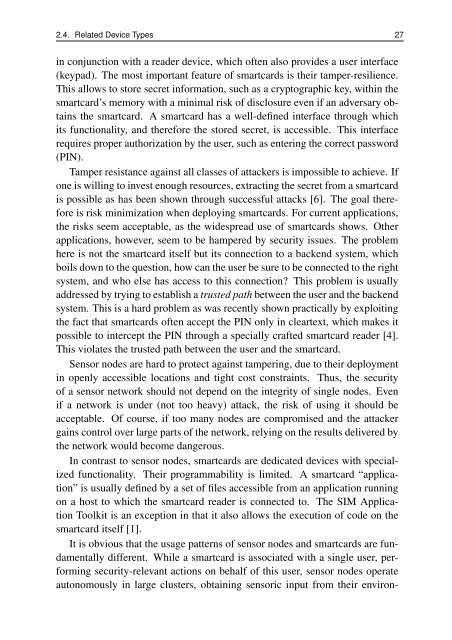Protocols for Secure Communication in Wireless Sensor Networks
Protocols for Secure Communication in Wireless Sensor Networks
Protocols for Secure Communication in Wireless Sensor Networks
Create successful ePaper yourself
Turn your PDF publications into a flip-book with our unique Google optimized e-Paper software.
2.4. Related Device Types 27<br />
<strong>in</strong> conjunction with a reader device, which often also provides a user <strong>in</strong>terface<br />
(keypad). The most important feature of smartcards is their tamper-resilience.<br />
This allows to store secret <strong>in</strong><strong>for</strong>mation, such as a cryptographic key, with<strong>in</strong> the<br />
smartcard’s memory with a m<strong>in</strong>imal risk of disclosure even if an adversary obta<strong>in</strong>s<br />
the smartcard. A smartcard has a well-def<strong>in</strong>ed <strong>in</strong>terface through which<br />
its functionality, and there<strong>for</strong>e the stored secret, is accessible. This <strong>in</strong>terface<br />
requires proper authorization by the user, such as enter<strong>in</strong>g the correct password<br />
(PIN).<br />
Tamper resistance aga<strong>in</strong>st all classes of attackers is impossible to achieve. If<br />
one is will<strong>in</strong>g to <strong>in</strong>vest enough resources, extract<strong>in</strong>g the secret from a smartcard<br />
is possible as has been shown through successful attacks [6]. The goal there<strong>for</strong>e<br />
is risk m<strong>in</strong>imization when deploy<strong>in</strong>g smartcards. For current applications,<br />
the risks seem acceptable, as the widespread use of smartcards shows. Other<br />
applications, however, seem to be hampered by security issues. The problem<br />
here is not the smartcard itself but its connection to a backend system, which<br />
boils down to the question, how can the user be sure to be connected to the right<br />
system, and who else has access to this connection? This problem is usually<br />
addressed by try<strong>in</strong>g to establish a trusted path between the user and the backend<br />
system. This is a hard problem as was recently shown practically by exploit<strong>in</strong>g<br />
the fact that smartcards often accept the PIN only <strong>in</strong> cleartext, which makes it<br />
possible to <strong>in</strong>tercept the PIN through a specially crafted smartcard reader [4].<br />
This violates the trusted path between the user and the smartcard.<br />
<strong>Sensor</strong> nodes are hard to protect aga<strong>in</strong>st tamper<strong>in</strong>g, due to their deployment<br />
<strong>in</strong> openly accessible locations and tight cost constra<strong>in</strong>ts. Thus, the security<br />
of a sensor network should not depend on the <strong>in</strong>tegrity of s<strong>in</strong>gle nodes. Even<br />
if a network is under (not too heavy) attack, the risk of us<strong>in</strong>g it should be<br />
acceptable. Of course, if too many nodes are compromised and the attacker<br />
ga<strong>in</strong>s control over large parts of the network, rely<strong>in</strong>g on the results delivered by<br />
the network would become dangerous.<br />
In contrast to sensor nodes, smartcards are dedicated devices with specialized<br />
functionality. Their programmability is limited. A smartcard “application”<br />
is usually def<strong>in</strong>ed by a set of files accessible from an application runn<strong>in</strong>g<br />
on a host to which the smartcard reader is connected to. The SIM Application<br />
Toolkit is an exception <strong>in</strong> that it also allows the execution of code on the<br />
smartcard itself [1].<br />
It is obvious that the usage patterns of sensor nodes and smartcards are fundamentally<br />
different. While a smartcard is associated with a s<strong>in</strong>gle user, per<strong>for</strong>m<strong>in</strong>g<br />
security-relevant actions on behalf of this user, sensor nodes operate<br />
autonomously <strong>in</strong> large clusters, obta<strong>in</strong><strong>in</strong>g sensoric <strong>in</strong>put from their environ-
















